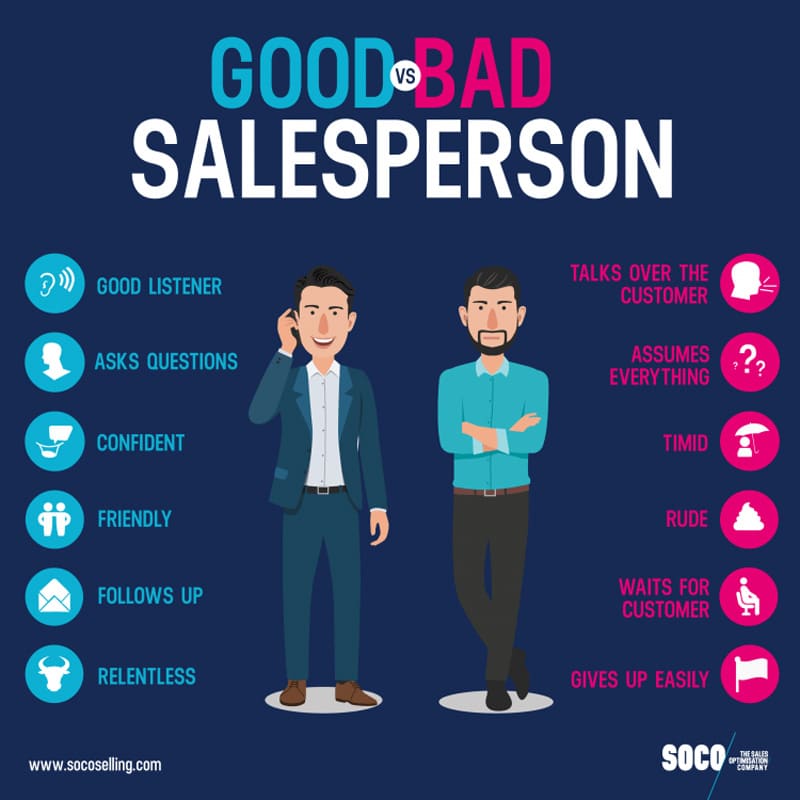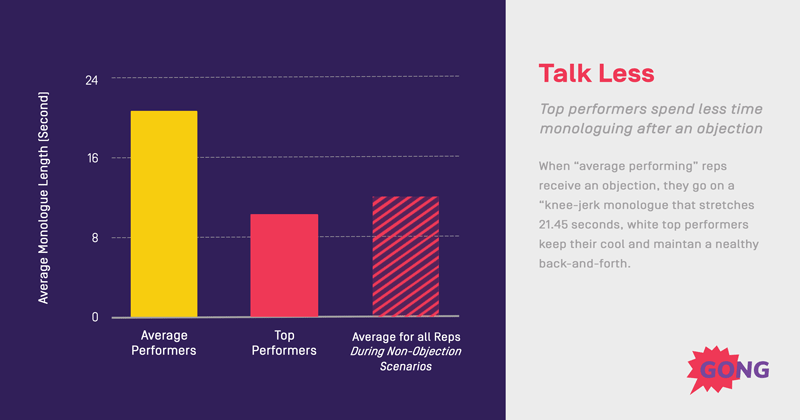Sales live from communication. Especially when the offer needs to be explained, is a little bit pricier and not part of everyday needs. As a sales rep you are in demand to present, advise, convince and negotiate close to the customer.
The most important thing is to speak the language of each customer. This means, first and foremost, treating each contact person as an individual and not working exclusively with ready-made advertising messages and discussion guides.
Be creative! Your sales talks should always be prepared and tailored to the individual customer so that he or she can directly recognize the individual benefit.
- Define your target audience as precisely as possible
- Collect references from existing customers
- Recognize your customers' problems and pains and offer them real solutions
- Accept your own limits
- Use best practices from real cases
- Talk to the right person
- Choose an adequate conversation opener
- Find the right channel
1. Define Your Target Audience as Precisely as Possible
The product that every customer absolutely needs at any time and is only offered by one supplier is the absolute dream of every sales rep in B2B. Obviously, that only happens in very few cases.
Most products or services require a certain talent for sales, which means that they are not suitable for everyone and must meet certain criteria to arouse interest. In other words, the customer must have a basic need that you can trigger with your offer.
Whether your prospects have such a need depends on both permanently unchangeable and temporary factors. The first and most important step to find companies aka. potential customers is to define your target audience as precisely as possible.
- What is your customer’s target market?
- Which industry is your customer in?
- Who do you need to address in the target company?
- Does a potential customer have to reach a certain “size”?
- How is this size defined, and on which key business figures?
- Can you provide your customer with a national or even international offer?
- Is your target audience locally active in a certain region or active globally?
- Which characteristics do your existing customers have in order for your offer to match their need?
The more precise and detailed your target audience is defined, the easier it is to build up a basic framework for a sales talk that forms the basis for an individual approach.
2. Collect References from Existing Customers
Winning customers in B2B is not only a huge sales success in terms of revenue. Getting your customer to review or recommend your product or service is a valuable link in the chain of a sales strategy far beyond the actual deal. For example, if your company sells phone systems for small businesses, you could ask small business owners who currently use one of your systems to review your product.
Reviews are the basic prerequisite for working with referral marketing. Even if reviews and recommendations are not always easy to elicit, especially in B2B, the positive experience with a customer, within the industry or even within a local environment, can certainly act as a door opener.
In addition, reference customers also serve as illustrative material for optimizing the definition of target audiences. The more reference customers you can include in the target audience analysis, the easier it is to identify patterns that will enable you to select potential customers in a goal-oriented manner.
3. Recognize Your Customers' Problems and Pains and Offer them Real Solutions
The best sales argument is to identify a current problem of the customer, for which your offer is a recognizable solution. In order to use it, you need to know what challenges your target audience faces in everyday business life. Furthermore, you need to know and above all, be able to show how your offer can help them cope with their pains.
In principle, these questions arise from the start of a company or when planning and developing new products or services, but you should also regularly use the experience gained from dealing with existing customers.
- How can your offer help the customer?
- How was the problem dealt with before?
- How could your offer improve the given situation?
The objective of such an analysis is to be well prepared for the potential new customer. You must be able to actively address problems and offer solutions that are immediately obvious to the contact person and leave them with as few open questions as possible.
4. Accept Your Own Limits
Customers are allowed to be demanding. A product or a service should solve an existing problem for them – the more comprehensive this is, the better. Wherever it is advantageous for the customer and you are easily able to do so, you should adapt and, if necessary, expand your offer.
However, do not lose sight of your core competence and do not create excessive additional work that you cannot manage. Make sure that no false expectations are raised in the sales talk. Remain realistic and clearly define what your product or service can or cannot fulfill.
5. Use Best Practices from Real Cases
Theory is good and we all need it, but examples make a problem and solution much easier to understand. No matter how technically competent you are and how convincingly you describe your offer in a sales talk and present it using presentation media, theory can rarely replace practical application completely.
It is not always possible to give the customer something to try out live, and it is not always possible to recognize the individual benefit at first glance. Examples from practice are therefore often the better format for a sales talk to convince your dialogue partner.
Present the customer with a concrete example of an existing customer's use case in a sales talk. The more similar their initial situation and problem, the more convincing are the solutions provided by your product or service. Design the description of concrete application examples in such a way that they are plausible and comprehensible without allowing conclusions to be drawn about the customer at first glance.
Orientate the application example as precisely as possible to the requirements of your target audience. In other words, do not necessarily present a medium-sized company with the use case of a large corporation and, conversely, do not try to impress a multinational corporation by describing the use case in a local crafts company.

Source: www.socoselling.com
6. Talk to the Right Person
Your offer may be perfect, the price adequate and the timing just right – but you spoke to the wrong person. There are few experiences more frustrating for a salesperson than spending hours, days or even weeks trying to convince a prospect, only to find out shortly before a deal is closed that the contact person was the wrong person to talk to.
Wrong means, above all, that he or she does not have the necessary skills to make the right decisions. If a further communication partner must be consulted for this, there is the danger that the entire work of persuasion performed up to then was in vain or must be started again more or less from zero.
Metaphorically speaking, the telephone switchboard is always the worst way to the customer. A good sales rep knows who to talk to before he or she reaches for the phone or favorite phone system. Therefore research can help you identify the various hierarchies and suitable contact people within a company.
7. Choose an Adequate Conversation Opener
Starting is always the hardest part. The biggest challenge for the sales department is to attract attention and the interest of prospects.
To address a responsible person in the company without any reason is the form of cold calling with the least chance of success. Even if you are well informed about your target customer and have good sales arguments, without the right "door opener" you often do not even get the opportunity to enter into a sales conversation.
So-called trigger events offer a great opportunity to overcome this hurdle. A trigger event is an event concerning a company indicating a concrete need. These can be economically positive signals, such as an announced profit increase, information about an expansion or merger with another company, announced personnel growth or the move to a new company building.
Examples like these and comparable trigger events provide indications of concrete needs: Maybe a company needs specific products and services in the context of an expansion of operations. In any case, trigger events can be used as a nice conversation opener.
In this way, the sales employee demonstrates that he or she is not simply randomly calling companies from the business directory, but has informed him/herself and can show a reason for contacting them.
8. Find the Right Channel
You know your customer. You know who you want to get in contact with. You know how to attract his or her attention and you have the right arguments to convince him or her. This raises the question of the best way to establish an initial contact. B2B Marketing and B2B sales today can use a variety of channels, through which customers can be reached today. These include:
- Personal Contact – Visits
- Trade Fairs
- Phone
- Business Networks – Social Media
Reaching out to someone via business networks or social media not only provides the opportunity to obtain information about the contact person, but also to contact this person if he or she is not available by phone. The next question that arises is: How to behave in an actual sales conversation? Let’s have a quick look at that topic:
How to Improve Your Sales Conversations
1. Active Listening
This might seem obvious but being a good listener is crucial to successful selling. You might be tempted to talk a lot and ask many questions to find out about your prospects pain points. But…let them speak, too. A potential customer will not be convinced of your product if you talk him or her into buying it. Give your contact time to respond to questions, take notes and paraphrase the things they said, so you don’t miss important topics. The feeling of being listened to and understood creates a relaxed and open atmosphere – perfect to make a prospect a new offer to soothe their pain.

Source: www.gong.io
2. Sympathy and Trust
Of course, you want to win the prospect over right away in the first minutes. You prepare your pitch to every tiny detail and rehearse it in your head over and over again. There is nothing bad about it, but keep in mind: People want to talk to real people, not to machines. Try to be as natural as possible. Be prepared but not staged. The next step is to build up trust. You do so by trying to help your future customer (listen carefully, see point 1.) and do what you promised to do – if you promised to send over documents the next day, send those documents over the next day!
3. Keeping Your Cool
There is a phrase which pretty much sums up everything: Show competence and you will build confidence. If you did your research on your prospect, prepared the call in advance and know your product and service in detail, you will remain calm in any given situation. Your prospect asks a ton of questions? No big deal, since you know your stuff. Your prospects wants to know about specific features or the technology behind your tools? You did your homework or at least know who you can refer to if the questions get too specific.
Conclusion
There is a lot more to a sales call than just being talkative and convincing. It’s also not only psychological or a nice chat. A successful sales conversation requires solid preparation – even more than rhetorical talent or salesmanship. The key to success is to know
a) who the customer is,
b) the right contact person,
c) the best way to reach him or her,
d) a suitable introduction to the initial contact and
e) convincing sales arguments tailored to the target customer.
Freely accessible company information can be provided by news portals, company websites, commercial registers as well as social media platforms. That large amount of usable information in combination with data on one's own sales activities, can be used as a basis to create a complete picture of the potential customer.
In the next step – after having done enough preparatory work – it is time to dive into the conversation and keep an eye on how you present yourself and how you approach people in a smooth, but not too silky way. The key elements of a successful sales conversations are:
- The right amount of listening and speaking
- Being both likeable and authentic
- Don’t seem desperate
